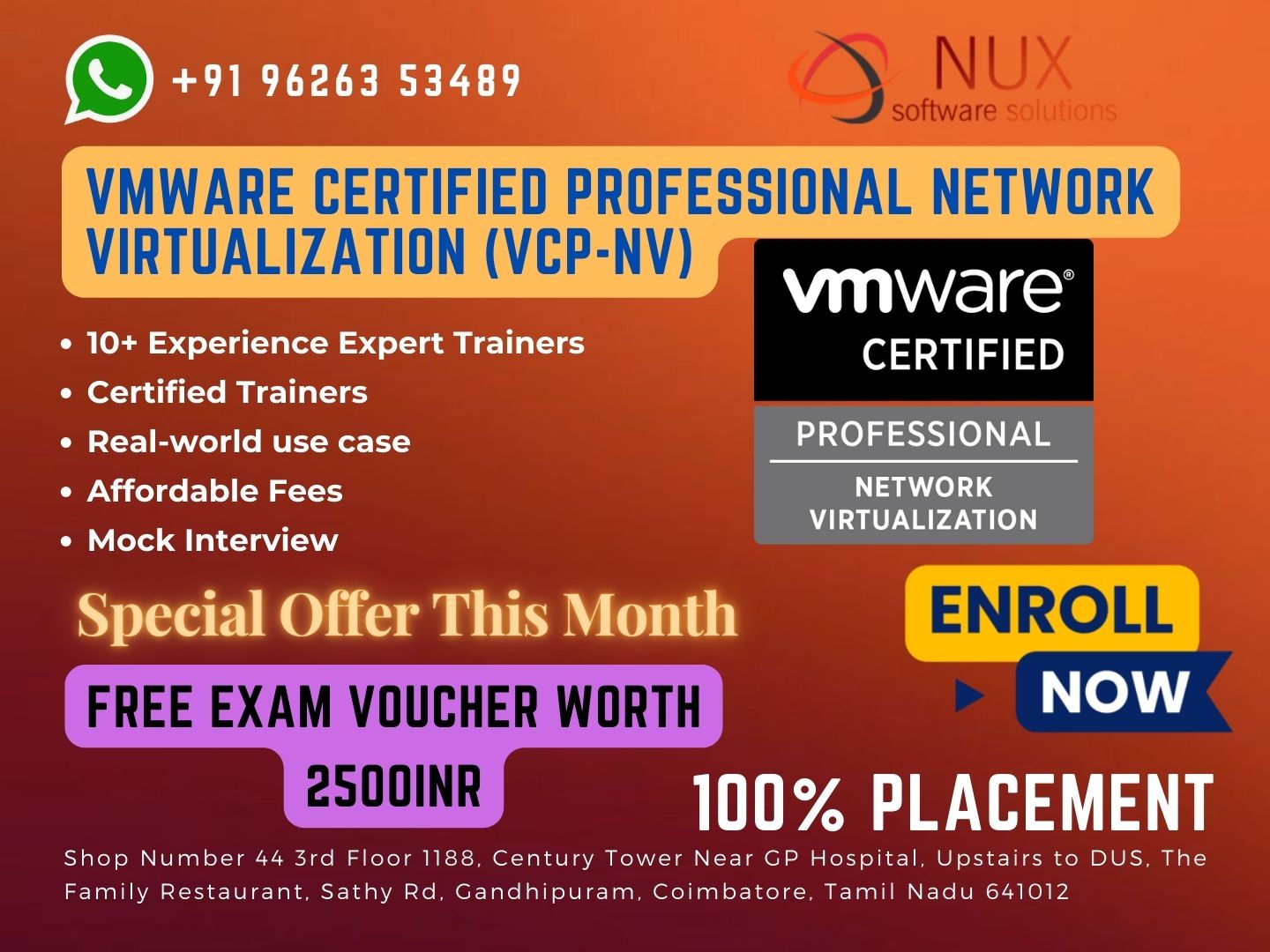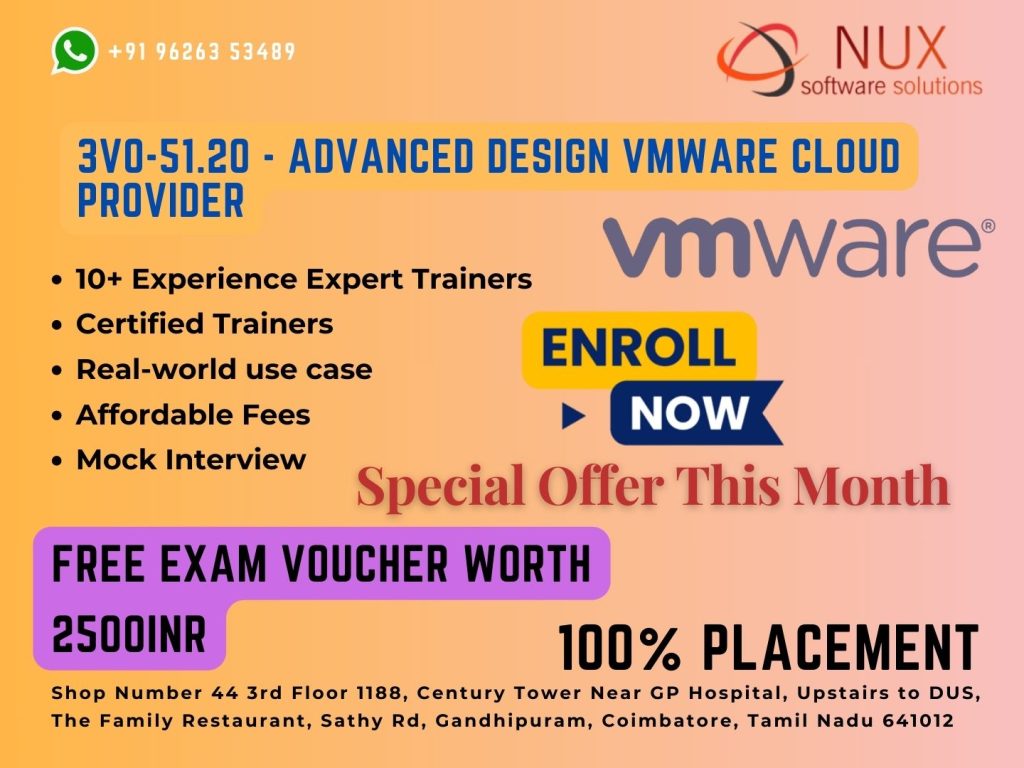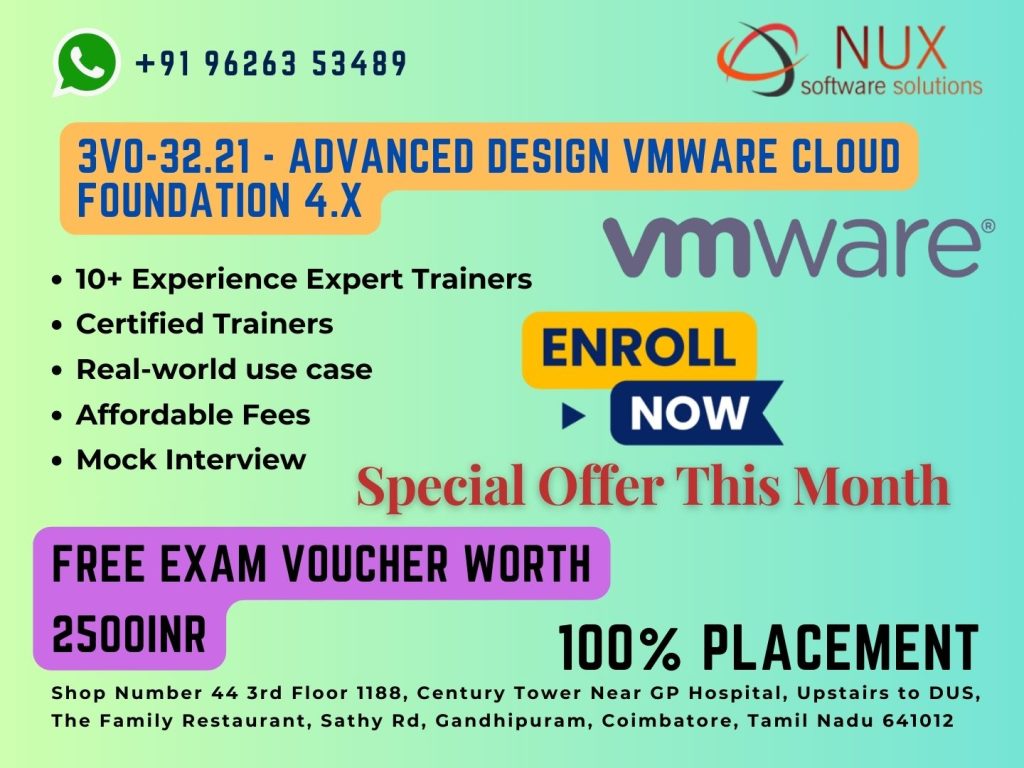VMware Security Network Virtualization (VCA6-NV)

Course Overview
The VMware Security Network Virtualization (VCA6-NV) certification training provides a strong foundation in software-defined networking (SDN) and network security virtualization using VMware NSX. It is ideal for professionals starting their journey in virtualized networking or preparing to pursue advanced NSX certifications like VCP-NV.
Participants will learn the fundamentals of network virtualization architecture, micro-segmentation, firewalling, and security policy management in NSX environments. This training also prepares candidates for the VCA6-NV certification exam, validating their knowledge of VMware’s approach to secure network virtualization.
Why Choose This Course
Gain a solid introduction to NSX and software-defined networking concepts
Understand VMware’s approach to network security, segmentation, and policy enforcement
Build foundational knowledge to pursue advanced certifications like VCP-NV
Learn how virtual networks improve agility, scalability, and security in cloud and data center environments
Ideal for those new to VMware NSX or working in hybrid network/security roles
Who Should Enroll
New IT professionals entering the virtual networking and security domain
System administrators and support engineers managing VMware-based networks
Network and security teams looking to adopt micro-segmentation strategies
Students and career switchers seeking a foundational VMware networking certification
Candidates preparing for the VCA6-NV certification
Skills You Will Gain
Understanding the architecture and benefits of VMware NSX
Exploring logical switching, routing, and distributed firewall concepts
Learning how micro-segmentation improves security and compliance
Analyzing real-world use cases for NSX in data centers and cloud environments
Navigating the VMware NSX Manager, and understanding basic policy configuration workflows
Recognizing integration points with vSphere, vCenter, and third-party security tools
Career Opportunities
Junior Network Virtualization Engineer
IT Support Engineer – Virtualization Track
Network and Security Analyst
Associate VMware Administrator
Cloud Infrastructure Intern
VCA6-NV is ideal for professionals building careers in virtualization, network security, and software-defined infrastructure, particularly in organizations investing in VMware NSX and SDN solutions.
Start Your Journey in Secure Network Virtualization with VMware NSX
The VCA6-NV certification validates your knowledge of virtualized network security and positions you for advanced growth in the world of software-defined infrastructure.
Enroll in VMware VCA6-NV Training at Linux Training Center, Coimbatore
VMware VCA6-NV Syllabus
Modules
Section 1: Explain SDDC and Network Virtualization Concepts and Use Cases
Compare traditional Data Center and Networking challenges with SDDC and Network Virtualization benefits
knowledge
- Understand vSphere virtual switching
- Identify uses and benefits of a vSphere standard switch
- Identify uses and benefits of a vSphere distributed switch
Tools:
- Virtualization Basics
- vSphere Networking 6.0 Update 2
- VMware Network Virtualization Fundamentals 2016 eLearning Course
- vSphere Web Client
Describe Network Virtualization concepts
knowledge:
- Identify how a physical switched network is architected
- Identify a network with and without VLANs
- Identify and explain access ports
- Identify and explain trunk ports
Tools:
- Virtualization Basics
- vSphere Networking 6.0 Update 2
- VMware Network Virtualization Fundamentals 2016 eLearning Course
- vSphere Web Client
Describe SDDC concepts and basic virtualization architecture
Knowledge:
- Identify and explain virtual machine port groups
- Identify and explain uplink ports
- Differentiate between configuring virtual switch uplinks as access ports or trunk ports
- Identify automation, elasticity, security, and management challenges in a virtual and physically-switched Data Center
Tools:
- Virtualization Basics
- vSphere Networking 6.0 Update 2
- VMware Network Virtualization Fundamentals 2016 eLearning Course
- vSphere Web Client
Section 2: Differentiate VMware NSX Component and Services
Identify and differentiate NSX components Fabrics
Knowledge:
- Identify routing and switching requirements
- Identify how firewall services work without a network virtualization platform
- Identify how load balancing works without a network virtualization platform
- Identify how VPN services work without a network virtualization platform
- Explain how hypervisors and virtual switches run on top of a Compute Infrastructure
Tools:
- VMware Network Virtualization Fundamentals 2016 eLearning Course
- NSX Installation Guide
- NSX Administration Guide
- vSphere Networking 6.0 Update 2
- NSX Manager
- vSphere Web Client
Describe vSphere networking architecture and components
knowledge:
- Describe network virtualization
- Identify and differentiate between Data, Control and Management planes in a virtual network
- Identify and explain core NSX components such as Logical Switches, L2 Bridges and Logical Routers
Tools:
- VMware Network Virtualization Fundamentals 2016 eLearning Course
- NSX Installation Guide
- NSX Administration Guide
- vSphere Networking 6.0 Update 2
- NSX Manager
Compare and Contrast VXLAN logical switching benefits and functionality
Knowledge:
- Differentiate physical and virtual networking
- Identify traffic flows between VXLANs and VLANs with NSX
- Describe how Virtual Bridges connect virtual resources to physical workloads
- Describe routing prior to NSX
- Describe NSX logical routing
- Identify and explain vCenter Server and NSX Manager integration
- Identify and explain NSX Controller deployment
- Identify and explain NSX Controller Clusters
- Identify and explain NSX VXLAN deployment
Tools:
- VMware Network Virtualization Fundamentals 2016 eLearning Course
- NSX Installation Guide
- NSX Administration Guide
- vSphere Networking 6.0 Update 2
- NSX Manager
- vSphere Web Client
Compare and Contrast NSX logical routing benefits and functionality
Knowledge:
- Describe common enterprise level topologies with NSX
- Describe NSX Edge Services Gateway usage in a multiple tenant environment
- Describe NSX scalability for multiple tenant scenarios
Tools:
- VMware Network Virtualization Fundamentals 2016 eLearning Course
- NSX Installation Guide
- NSX Administration Guide
- vSphere Networking 6.0 Update 2
- NSX Manager
- vSphere Web Client
Describe NSX Edge services functionality
Knowledge:
- Identify tools for traffic flow visibility
- Identify traffic analysis tools
- Identify network inventory and fault management tools
- Identify logging, event tracking, and auditing tools
- Identify health check monitoring in an NSX overlay network
Tools:
- VMware Network Virtualization Fundamentals 2016 eLearning Course
- NSX Installation Guide
- NSX Administration Guide
- vSphere Networking 6.0 Update 2
- NSX Manager
Section 3: Differentiate NSX Security Benefits and Features
Compare and Contrast NSX Security benefits and functionality
Knowledge:
- Explain NSX Manager
- Explain NSX VXLANs
- Explain NSX Distributed Logical Routers
- Explain NSX Controllers
- Explain NSX Edge Services Gateways
- Explain advanced services such as Firewalls and Load Balancers
Tools:
- VMware Network Virtualization Fundamentals 2016 eLearning Course
- NSX Data Security Reference Guide
- NSX Installation Guide
- NSX Administration Guide
- vSphere Networking 6.0 Update 2
- NSX Manager
Describe NSX Logical Firewall services
Knowledge:
- Explain physical firewalls
- Explain virtual firewalls
- Explain NSX distributed firewall
Tools:
- VMware Network Virtualization Fundamentals 2016 eLearning Course
- NSX Installation Guide
- NSX Administration Guide
- vSphere Networking 6.0 Update 2
Compare and Contrast NSX Service Composer functionality
Knowledge:
- Explain NSX Service Composer
- Explain automated security policies
- Explain security groups
Tools:
- VMware Network Virtualization Fundamentals 2016 eLearning Course
- NSX Installation Guide
- NSX Administration Guide
- vSphere Networking 6.0 Update 2
Section 4: Differentiate NSX Network Virtualization Use Cases
Describe typical NSX Network Virtualization use cases
Knowledge:
- Explain common use cases for NSX
- Explain NSX micro-segmentation
- Explain NSX elasticity
- Explain NSX security
- Explain NSX management
Tools:
- VMware Network Virtualization Fundamentals 2016 eLearning Course
- VMware NSX Product Home
- NSX Data Security Reference Guide
- NSX Installation Guide
- NSX Administration Guide
- vSphere Networking 6.0 Update 2
Explain the role of NSX in Workforce Mobility and IT Security use cases
Knowledge:
- Explain common use cases for Workforce Mobility
- Explain common use cases for IT Security
- Describe the benefits of a structured IT approach to End User Computing
Tools:
- VMware Network Virtualization Fundamentals 2016 eLearning Course
- VMware NSX Product Home
- NSX Data Security Reference Guide
- VMware Workforce Mobility Fundamentals eLearning Course
Explain the role of NSX in IT Automation use cases
Knowledge:
- Explain common use cases for NSX in IT Automation
- Describe the benefits of vRealize Automation used in conjunction with NSX
- Describe the benefits of application delivery when using NSX with vRealize Automation
Tools:
- VMware Network Virtualization Fundamentals 2016 eLearning Course
- VMware NSX and vRealize Automation
- VMware NSX Product Home
- vSphere Networking 6.0 Update 2
Explain the role of NSX in application continuity and disaster recovery use cases
Knowledge:
- Explain common use cases for application continuity
- Explain common use cases for disaster recovery
- Describe the benefit of Cross-vCenter NSX with disaster recovery
Tools:
- VMware Network Virtualization Fundamentals 2016 eLearning Course
- Cross-vCenter NSX Installation Guide
- VMware NSX Product Home



